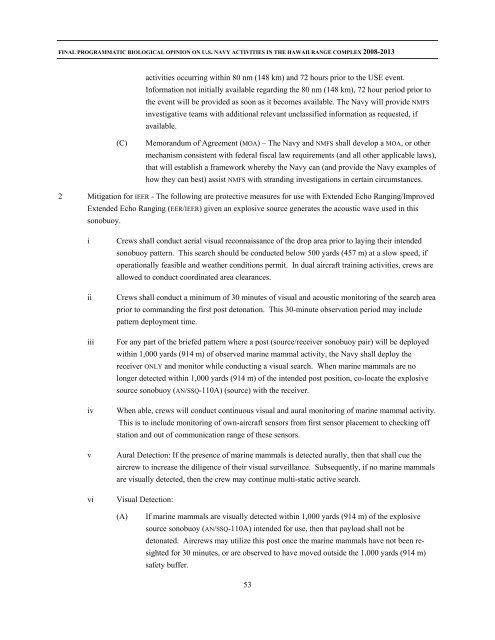NMFS Biological Opinion on U.S. Navy training ... - Govsupport.us
NMFS Biological Opinion on U.S. Navy training ... - Govsupport.us
NMFS Biological Opinion on U.S. Navy training ... - Govsupport.us
Create successful ePaper yourself
Turn your PDF publications into a flip-book with our unique Google optimized e-Paper software.
FINAL PROGRAMMATIC BIOLOGICAL OPINION ON U.S. NAVY ACTIVITIES IN THE HAWAII RANGE COMPLEX 2008-2013<br />
activities occurring within 80 nm (148 km) and 72 hours prior to the USE event.<br />
Informati<strong>on</strong> not initially available regarding the 80 nm (148 km), 72 hour period prior to<br />
the event will be provided as so<strong>on</strong> as it becomes available. The <strong>Navy</strong> will provide <str<strong>on</strong>g>NMFS</str<strong>on</strong>g><br />
investigative teams with additi<strong>on</strong>al relevant unclassified informati<strong>on</strong> as requested, if<br />
available.<br />
(C)<br />
Memorandum of Agreement (MOA) – The <strong>Navy</strong> and <str<strong>on</strong>g>NMFS</str<strong>on</strong>g> shall develop a MOA, or other<br />
mechanism c<strong>on</strong>sistent with federal fiscal law requirements (and all other applicable laws),<br />
that will establish a framework whereby the <strong>Navy</strong> can (and provide the <strong>Navy</strong> examples of<br />
how they can best) assist <str<strong>on</strong>g>NMFS</str<strong>on</strong>g> with stranding investigati<strong>on</strong>s in certain circumstances.<br />
2 Mitigati<strong>on</strong> for IEER - The following are protective measures for <strong>us</strong>e with Extended Echo Ranging/Improved<br />
Extended Echo Ranging (EER/IEER) given an explosive source generates the aco<strong>us</strong>tic wave <strong>us</strong>ed in this<br />
s<strong>on</strong>obuoy.<br />
i<br />
ii<br />
iii<br />
iv<br />
v<br />
vi<br />
Crews shall c<strong>on</strong>duct aerial visual rec<strong>on</strong>naissance of the drop area prior to laying their intended<br />
s<strong>on</strong>obuoy pattern. This search should be c<strong>on</strong>ducted below 500 yards (457 m) at a slow speed, if<br />
operati<strong>on</strong>ally feasible and weather c<strong>on</strong>diti<strong>on</strong>s permit. In dual aircraft <strong>training</strong> activities, crews are<br />
allowed to c<strong>on</strong>duct coordinated area clearances.<br />
Crews shall c<strong>on</strong>duct a minimum of 30 minutes of visual and aco<strong>us</strong>tic m<strong>on</strong>itoring of the search area<br />
prior to commanding the first post det<strong>on</strong>ati<strong>on</strong>. This 30-minute observati<strong>on</strong> period may include<br />
pattern deployment time.<br />
For any part of the briefed pattern where a post (source/receiver s<strong>on</strong>obuoy pair) will be deployed<br />
within 1,000 yards (914 m) of observed marine mammal activity, the <strong>Navy</strong> shall deploy the<br />
receiver ONLY and m<strong>on</strong>itor while c<strong>on</strong>ducting a visual search. When marine mammals are no<br />
l<strong>on</strong>ger detected within 1,000 yards (914 m) of the intended post positi<strong>on</strong>, co-locate the explosive<br />
source s<strong>on</strong>obuoy (AN/SSQ-110A) (source) with the receiver.<br />
When able, crews will c<strong>on</strong>duct c<strong>on</strong>tinuo<strong>us</strong> visual and aural m<strong>on</strong>itoring of marine mammal activity.<br />
This is to include m<strong>on</strong>itoring of own-aircraft sensors from first sensor placement to checking off<br />
stati<strong>on</strong> and out of communicati<strong>on</strong> range of these sensors.<br />
Aural Detecti<strong>on</strong>: If the presence of marine mammals is detected aurally, then that shall cue the<br />
aircrew to increase the diligence of their visual surveillance. Subsequently, if no marine mammals<br />
are visually detected, then the crew may c<strong>on</strong>tinue multi-static active search.<br />
Visual Detecti<strong>on</strong>:<br />
(A)<br />
If marine mammals are visually detected within 1,000 yards (914 m) of the explosive<br />
source s<strong>on</strong>obuoy (AN/SSQ-110A) intended for <strong>us</strong>e, then that payload shall not be<br />
det<strong>on</strong>ated. Aircrews may utilize this post <strong>on</strong>ce the marine mammals have not been resighted<br />
for 30 minutes, or are observed to have moved outside the 1,000 yards (914 m)<br />
safety buffer.<br />
53








